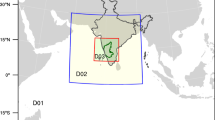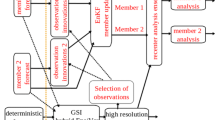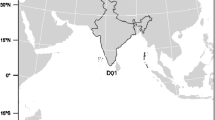Abstract
The quality of background error statistics (BES) is one of the key components for successful assimilation of observations in a numerical model. Considerable uncertainties and non-uniqueness exist, however, in prescribing BES; in particular, the prescription and impact of BES can also depend on the weather regime and not much is known in this regard over the Indian region. We have conducted a series of assimilation experiments using the WRF three-dimensional variational data assimilation (3D-Var) system with different BES to asses the relative improvement in model forecast due to different BES over the Indian region. The forecasted wind, temperature, and humidity are verified against NCEP analysis and conventional radiosondes, while the predicted rainfall is verified against Tropical Rainfall Measuring Mission (TRMM) observations. Using a number of parameters to quantify impact of BES, it is shown that the use of regional BES (RBES) in WRF 3D-Var significantly improves model forecast as compared to the control experiment (no assimilation) and Global BES (GBES). The use of RBES from National Meteorological Center (NMC) and ensemble perturbation (ENS) method in WRF 3D-Var produced similar impact on model forecasts except slight differences in wind speed. This study highlights the importance of domain-dependent and region-specific BES in WRF 3D-Var assimilation system; for the selected events, results obtained using RBES is found to be significantly better than GBES.















Similar content being viewed by others
References
Adler RF, Bolun DT, Curtis S, Nelkin EJ (2000) Tropical rainfall distributions determined using TRMM combined with other satellite and rain gauge information. J Appl Meteorol 39:2007–2023
Barker DM, Huang W, Guo YR, Bourgeois AJ, Xiao QN (2004) A three-dimensional variational data assimilation system for MM5: implementation and initial results. Mon Weather Rev 132:897–914
Brennan MJ, Hennon CC, Knabb RD (2009) The operational use of QSCAT ocean surface vector winds at the national hurricane center. Weather Forecast 24:621–645
Chen SH (2007) The impact of assimilating SSM/I and QSCAT satellite winds on Hurricane Isidore simulation. Mon Weather Rev 135:549–566
Chou S-H, Zavodsky B, Jedlovec G, and Lapenta W (2006) Assimilation of Atmospheric Infrared Sounder (AIRS) data in a regional model. In: Preprints, 14th conference on satellite meteorology and oceanography. American Meteorological Society, Atlanta, GA, CD-ROM, P5.12
Daget N, Weaver AT, Balmaseda MA (2009) Ensemble estimation of background-error variances in a three-dimensional variational data assimilation system for the global ocean. QJR Meteorol Soc 135:1071–1094
Deb SK, Kishtawal CM, Pal PK (2010) Impact of Kalpana-1 derived water vapor winds on Indian Ocean Tropical cyclones forecast. Mon Weather Rev (Early online release: doi:10.1175/2009MWR3041.1)
Doyle JD, Warner TT (1988) Verification of mesoscale objective analyses of VAS and rawinsonde data using the March 1982 AVE/VAS Special Network Data. Mon Weather Rev 116:358–367
Dudhia J (1989) Numerical study of convection observed during the winter monsoon experiment using a mesoscale two-dimensional model. J Atmos Sci 46:3077–3107
Fan X, Tilley SJ (2005) Dynamic assimilation of MODIS-retrieved humidity profiles within a regional model for high-latitude forecast Applications. Mon Weather Rev 133:3450–3480
Fisher M (2003) Background error covariance modeling. In: Proceedings of the seminar on recent developments in data assimilation for atmosphere and ocean. Reading, United Kingdom, ECMWF, pp 45–63
Gal-chen, Schmidt BD, Uccellini LW (1986) Simultaneous experiments for testing the assimilation of geostationary satellite temperature retrievals into a numerical prediction model. Mon Weather Rev 114:1213–1230
Goswami P, Gouda KC, Talagrant O (2005) Ensemble initial conditions through 4D-Var assimilation. Geophys Res Lett 32: L21801. doi:10.1029/2005GL022542
Guo YR, Kusaka H, Barker DM, Kuo YH, Crook A (2005) Impact of ground-based GPS PW and MM5-3DVar background error statistics on forecast of a convective case. SOLA 1:73–76
Harasti PR, McAdie CJ, Dodge PP, Lee WC, Tuttle J, Murillo ST, Marks FD (2004) Real-time implementation of single-doppler radar analysis methods for tropical cyclones: algorithm improvements and use with WSR-88D display data. Weather Forecast 19(2):219–239
Hatwar HR, Subrahmanyam V, Mohapatra M, Roy Bhowmik SK, Bandyopadyay BK, Singh CH, Srivastava K (2008) A report on the cyclonic storm “OGNI” 2006. India Meteorological Department, Meteorological Monograph, Cyclone Warning Division, 2/2008,73 pp
Hong SY, Dudhia J (2003) Testing of a new non-local boundary layer vertical diffusion scheme in numerical weather prediction applications. In: 20th conference on weather analysis and forecasting/16th conference on numerical weather prediction, Seattle, WA
Jayanthi N, Lele RR, Sunitha Devi S (2006) Cyclones, depressions over the North Indian ocean during 2005. Mousam 57(3):379–394
Kain JS (2004) The Kain–Fritsch convective parameterization: an update. J Appl Meteorol 43:170–181
Kalnay E (2003) Atmospheric modeling, data assimilation and predictability. Cambridge University press, 341 pp
Kelly GA, Bauer P, Geer AJ, Lopez P, Thepaut J-N (2008) Impact of SSM/I observations related to moisture, clouds, and precipitation on global NWP forecast skill. Mon Weather Rev 136:2713–2716
Lin YL, Farley RD, Orville HD (1983) Bulk parameterization of the snow field in a cloud model. J Clim Appl Meteorol 22:1065–1092
Lipton AE, Vonder haar TH (1990) Mesoscale analysis by numerical modeling coupled with sounding retrieval from satellites. Mon Weather Rev 118:1308–1329
Lipton AE, Modica GD, Heckman ST, Jackson AJ (1995) Satellite-model coupled analysis of convective potential in Florida with VAS water vapor and surface temperature data. Mon Weather Rev 123:3292–3304
Mazumdar AB, Lele RR, Sunitha Devi S (2007) Cyclones, depressions over north Indian ocean during 2006. Mousam 58(3):305–322
Michel Y, Auligne T (2010) Inhomogeneous background error modeling and estimation over Antartica. Mon Weather Rev 138:2229–2252
Mlawer EJ, Taubman SJ, Brown PD, Iacono MJ, Clough SA (1997) Radiative transfer for inhomogeneous atmosphere: RRTM, a validated correlated-k model for the long-wave. J Geophys Res 102(D14):16663–16682
Parrish DF, Derber JC (1992) The National Meteorological Center’s spectral statistical interpolation analysis system. Mon Weather Rev 120:1747–1763
Pereira MB, Berre L (2006) The use of an ensemble approach to study the background error covariances in a global NWP Model. Mon Weather Rev 134:2466–2489
Powers GJ (2007) Numerical prediction of an antarctic severe wind event with the weather research and forecasting (WRF) Model. Mon Weather Rev 135:3134–3157
Pu Z, Tao W-K, Braun S, Simpson J, Jia Y, Halverson J, Hou A, Olson W (2002) The impact of TRMM data on mesoscale numerical simulation of super typhoon Paka. Mon Weather Rev 130:2248–2258
Rakesh V, Singh R, Joshi PC (2009a) Intercomparison of the performance of MM5/WRF with and without satellite data assimilation in short range forecast applications over the Indian region. Meterol Atmos Phys 105:133–155
Rakesh V, Singh R, Pal PK, Joshi PC (2009b) Impact of satellite observed surface wind and total precipitable water on WRF short-range forecasts over Indian region during monsoon 2006. Weather Forecast 24:1706–1731
Routry A, Mohanty UC, Niyogi Dev, Rizvi SRH, Osuri KK (2010) Simulation of heavy rainfall events over Indian monsoon region using WRF-3DVAR data assimilation system. Meterol Atmos Phys 106:107–127
Ruggiero FH, Sashegyi KD, Lipton AE, Madala RV, Raman S (1999) Coupled assimilation of geostationary satellite sounder data into a mesoscale model using the Bratseth analysis approach. Mon Weather Rev 7:802–820
Sandeep S, Chandrasekar A, Singh D (2006) The impact of assimilation of AMSU data for the prediction of a tropical cyclone over India using a mesoscale model. Int. J Remote Sens 27:4621–4653
Singh R, Pal PK, Kishtawal CM, Joshi PC (2008a) The impact of variational assimilation of SSM/I and QSCAT satellite observations on the numerical simulation of Indian ocean tropical cyclone. Weather Forecast 23:460–476
Singh R, Pal PK, Kishtawal CM, Joshi PC (2008b) Impact of atmospheric infrared sounder data on the numerical simulation of mumbai historical rain event. Weather Forecast 23:892–913
Skamarock WC, Klemp JB, Dudhia J, Gill DO, Barker DM, Wang W, Powers JG (2005) A description of the advanced research WRF, Version 2. NCAR Tech. Note., NCAR/TN-468 + STR, 88 pp. [Available from UCAR Communications, P.O. Box 3000, Boulder, CO 80307]
Srivastava KJ, Gao K, Brewster SK, Roy Bhowmik M, Xue R, Gadi (2010) Assimilation of Indian radar data with ADAS and 3DVAR techniques for simulation of a small-scale tropical cyclone using ARPS model. Nat Hazards. doi:10.1007/s11069-010-9640-4
Vinodkumar, Chandrasekhar A, Alapaty K, Niyogi D (2008) The impacts of indirect soil moisture assimilation and direct surface temperature and humidity assimilation on a mesoscale model simulation of an Indian Monsoon depression. J Apply Meteor Climatol 47:1393–1412
Wilks D (2006) Statistical methods in the atmospheric sciences: an introduction, 2nd edn. Academic Press, New York, 627 pp
Wu WS, Purser R, Parrish D (2002) Three-dimensional variational approach analysis with spatially inhomogeneous covariances. Mon Weather Rev 130:2905–2916
Zapotocny TH, Jung JA, LeMarshall JF, Treadon RE (2007) A two season impact study of satellite and In Situ data in the NCEP global data assimilation system. Weather Forecast 22:887–909
Zhang X, Xiao Q, Patrick F (2007) The impact of multi-satellite data on the initialization and simulation of Hurricane Lili’s (2002) rapid weakening phase. Mon Weather Rev 135:526–548
Zou X, Xiao Q (2000) Studies on the initialization and simulation of a mature hurricane using a variational bogus data assimilation scheme. J Atmos Sci 57:836–860
Acknowledgments
The authors gratefully acknowledge Mesoscale and Microscale Meteorology division at the National Center for Atmospheric Research (NCAR) for access and support of WRF and its 3D-Var assimilation system. The authors also acknowledge the National Centers for Environmental Prediction (NCEP) for making analysis data available at their site. The radiosonde data were obtained from the University of Wyoming website. The ICOADS data were obtained from ftp.dss.ucar.edu. The AIRS and TRMM data were obtained from NASA websites and is gratefully acknowledged. The authors thank Dr. Dale Barker and Dr. S. R. H. Rizvi of NCAR for discussions regarding the generation of BES for WRF 3D-Var. The authors thank the anonymous reviewers for their critical and insightful comments/suggestions, which were helpful in substantially improving the presentation of the manuscript. This work was supported by a research grant from CSIR (PPD), India.
Author information
Authors and Affiliations
Corresponding author
Additional information
Responsible editor: C. Simmer.
Rights and permissions
About this article
Cite this article
Rakesh, V., Goswami, P. Impact of background error statistics on 3D-Var assimilation: case study over the Indian region. Meteorol Atmos Phys 112, 63–79 (2011). https://doi.org/10.1007/s00703-011-0128-x
Received:
Accepted:
Published:
Issue Date:
DOI: https://doi.org/10.1007/s00703-011-0128-x




